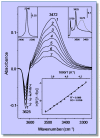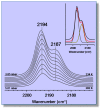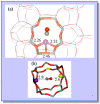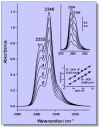Probing Gas Adsorption in Zeolites by Variable-Temperature IR Spectroscopy: An Overview of Current Research
- PMID: 28914812
- PMCID: PMC6151591
- DOI: 10.3390/molecules22091557
Probing Gas Adsorption in Zeolites by Variable-Temperature IR Spectroscopy: An Overview of Current Research
Abstract
The current state of the art in the application of variable-temperature IR (VTIR) spectroscopy to the study of (i) adsorption sites in zeolites, including dual cation sites; (ii) the structure of adsorption complexes and (iii) gas-solid interaction energy is reviewed. The main focus is placed on the potential use of zeolites for gas separation, purification and transport, but possible extension to the field of heterogeneous catalysis is also envisaged. A critical comparison with classical IR spectroscopy and adsorption calorimetry shows that the main merits of VTIR spectroscopy are (i) its ability to provide simultaneously the spectroscopic signature of the adsorption complex and the standard enthalpy change involved in the adsorption process; and (ii) the enhanced potential of VTIR to be site specific in favorable cases.
Keywords: IR spectroscopy; VTIR spectroscopy; dual sites; gas adsorption; zeolites.
Conflict of interest statement
The authors declare no conflict of interests.
Figures











References
-
- Wang Q.A., Luo J.Z., Zhong Z.Y., Borgna A. CO2 capture by solid adsorbents and their applications: Current status and new trends. Energy Environ. Sci. 2011;4:42–55. doi: 10.1039/C0EE00064G. - DOI
-
- Yazaydin A.O., Snurr R.Q., Park T.H., Koh K., Liu J., LeVan M.D., Benin A.I., Jakubeczak P., Lanuza M., Galloway D.B., et al. Screening metal-organic frameworks for carbon dioxide capture from flue gas using a combined experimental and modeling approach. J. Am. Chem. Soc. 2009;131:18198–18199. doi: 10.1021/ja9057234. - DOI - PubMed
-
- Dietzel P.D.C., Johnsen R.E., Fjellvaj H., Bordiga S., Groppo E., Chavan S., Blom R. Adsorption properties and structure of CO2 adsorbed on open coordination sites of metal-organic framework Ni2(dhtp) from gas adsorption, IR spectroscopy and X-ray diffraction. Chem. Commun. 2008;7:5125–5127. doi: 10.1039/b810574j. - DOI - PubMed
Publication types
MeSH terms
Substances
LinkOut - more resources
Full Text Sources
Other Literature Sources

